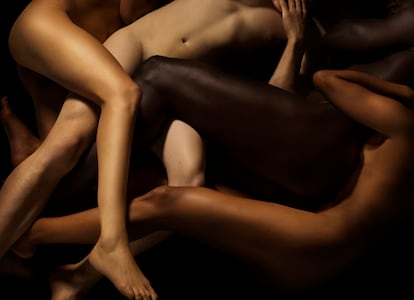Men always want it, women have a headache: Debunking the biggest myths about gendered takes on sex
Experts explain how a revolution of sexual desire is afoot that looks to end the stigma and shame experienced by women who want to feel pleasure

The word libido comes from the Latin libīdo, which means desire or lust. In psychology and medicine, the term is used to denominate a person’s sexual desire, a yearning that leads men and women alike to seek a full and satisfying sexual relationship. When you look at the term through this lens, libido seems to be a simple matter, but the truth is that an infinite number of myths have sprung up around it throughout history. Among these, one of the most common is the belief that men always have sexual desire and women do not. More and more researchers are pointing out, however, that female sexual desire is in the midst of a pleasure revolution that is intent on doing away with the stigma and guilt that women have traditionally felt for having an active libido.
Ana Lombardía, author of the book Hablando con ellos. La sexualidad de los hombres heteros [Talking with them: Heterosexual mens’ sexuality] (Oberon, 2022) explains that the panorama is changing markedly, throughout many countries. “We are living an authentic revolution of female sexual pleasure in which women are asking for sexual relationships that are pleasurable for them, too. Women no longer want to just be penetrated.”
Sexologist and general health psychologist at Madrid therapy organization Centro TAP, Ana Antelo Pousa, says that words like guilt and shame show up a lot in her consultations with women who come to her with worries about having a powerful libido. “In our society, feminine desire could not be demonstrated, women were the ones who had to be courted and there was a very intense stigma to which women were subjected when they expressed their desire. Take, for example, the figure of the femme fatale.” From tradition came stigma, and stigma brought guilt along for the ride.
But that hasn’t always been the case. Sexuality has evolved with the mentality of human beings. That’s how Coral Herrera Gómex explains it in the book La construcción sociocultural del deseo y el erotismo [Sociocultural construction of desire and eroticism]: “Desire and eroticism are human impulses that determine our way of relating to others and to the objects around us.” They have always been extolled as part of the mysteries of life in poetry and literature, especially during the 19th century, when the Romantics expressed their desires and the frustration they felt over not being able to reach the object of their passions. This is why desire is “a political, social and economic construction that varies according to country and historical epoch. This human quality is innate, but learned: eroticism is determined by our emotional and relational structures; we inherit those structures mainly through culture,” says Herrera.
Until now, explain researchers, sexual relations have always centered on the man’s pleasure. “Sex took place when he wanted it, and women complied,” says Lombardía. Nowadays, the expert explains, it’s necessary that both people involved feel sexual desire for the encounter to take place, which has had the effect of diminishing the amount of sex we have: it’s no longer only about what he wants. “It’s impossible to measure sexual desire with any exactitude, but we can get an idea, and based on the conclusions of diverse studies, it appears that couples are giving less and less importance to desire and sex,” explains sexologist Ana García.
Feminine desire could not be shown, women were the ones who had to be courted and there was a very intense stigma to which women were subjected when they expressed their desire
A pan-European study conducted by Yougov for Gleeden, Infidelity and the evolution of relationships in Spain and Europe in 2022, suggests that only 25% of Spaniards are really satisfied with their sex life. García says that “if 75% of the people in the study do not find solutions for improving their sex life, desire will disappear.” There are studies that show that people are having less sex now than they did 50 years ago. Specifically, the National Survey of Sexual Attitudes and Lifestyles found that in 1990, couples between the ages of 16 and 64 made love five times a month, a number that dropped to four times in 2000 and three in 2010. This means that over the course of 20 years, the number has dropped by 40%.
Myths that characterize women as passive entities who can only wait around until they are hunted down by a man have had negative impacts on men themselves. So much so, explain psychologists consulted for this article, that the thought that they should always want sex is undermining men’s sense of their own masculinity: it worries them. A supposed lack of manly impetus is already the second most common reason why younger men go to sexual health specialists, second only to premature ejaculation, according to sources contacted for this article.
Sexuality and psychology expert Alberto Álamo says that the cliché persists that men always want sex and women always have a headache. This is a myth that does not line up with the number of men who come to his office looking for help with flagging sexual desire. “The main problem is not lack of desire, but rather the change men go through once their relationship has been established. Once that first phase of falling in love passes, this problem can arise. Men are very visual and are more excited by novelty”, says Álamo. In his practice, he sees proof every day of how the pressure on men to maintain a high libido leads to erectile dysfunction issues: “When we get them to relax and remove the pressure that society places on them, the penis can usually become erect again.”
Lombardía says that “sexual relations based on penetration don’t excite the majority of women, who in many cases have stopped having this kind of sex because they have discovered that they can have a good time on their own.” In this vein, sexologist Antelo says the “sex toys have decentralized erotic desire for the penis. Nowadays, women can be at the center of pleasure. Today, we dare to speak of sexuality and to enjoy it without shame.”
Sexual desire depends on how relaxed the woman is
Sexual desire is characterized by two factors: “The first is subjective, what for one person can be high sexual desire may not be enough for another. On the other hand, it can be influenced by a variety of factors: biological, psychological, social and environmental,” explains García.
Low sexual desire among women has never been taken seriously enough, and due to that fact, there are almost no scientific studies on the subject. Nonetheless, some factors that can influence a loss of desire are hormonal. Birth control pills, for example, can cause a loss of libido as a side effect. Lombardía says that “it’s paradoxical that women take hormones to be able to have sex, when those same pills can take away their libido.” Other factors that can alter levels of sexual desire are stress, not getting enough rest and anxiety. Women’s pleasure expert Andrea Aguilar says that “the body always asks for more of what it likes. If a sexual encounter is pleasurable, we’ll always want to repeat it.”
Sign up for our weekly newsletter to get more English-language news coverage from EL PAÍS USA Edition
Tu suscripción se está usando en otro dispositivo
¿Quieres añadir otro usuario a tu suscripción?
Si continúas leyendo en este dispositivo, no se podrá leer en el otro.
FlechaTu suscripción se está usando en otro dispositivo y solo puedes acceder a EL PAÍS desde un dispositivo a la vez.
Si quieres compartir tu cuenta, cambia tu suscripción a la modalidad Premium, así podrás añadir otro usuario. Cada uno accederá con su propia cuenta de email, lo que os permitirá personalizar vuestra experiencia en EL PAÍS.
¿Tienes una suscripción de empresa? Accede aquí para contratar más cuentas.
En el caso de no saber quién está usando tu cuenta, te recomendamos cambiar tu contraseña aquí.
Si decides continuar compartiendo tu cuenta, este mensaje se mostrará en tu dispositivo y en el de la otra persona que está usando tu cuenta de forma indefinida, afectando a tu experiencia de lectura. Puedes consultar aquí los términos y condiciones de la suscripción digital.
More information
Últimas noticias
Most viewed
- Sinaloa Cartel war is taking its toll on Los Chapitos
- Oona Chaplin: ‘I told James Cameron that I was living in a treehouse and starting a permaculture project with a friend’
- Reinhard Genzel, Nobel laureate in physics: ‘One-minute videos will never give you the truth’
- Why the price of coffee has skyrocketed: from Brazilian plantations to specialty coffee houses
- Silver prices are going crazy: This is what’s fueling the rally











































